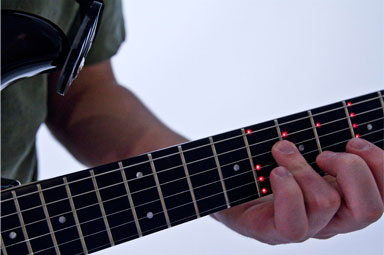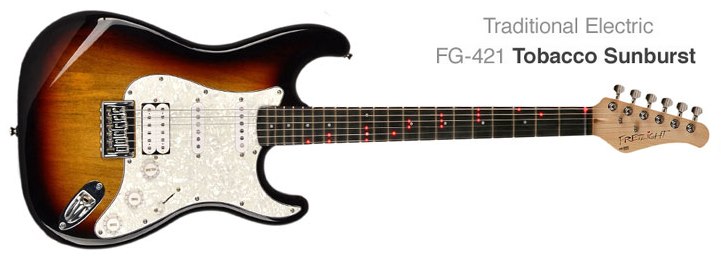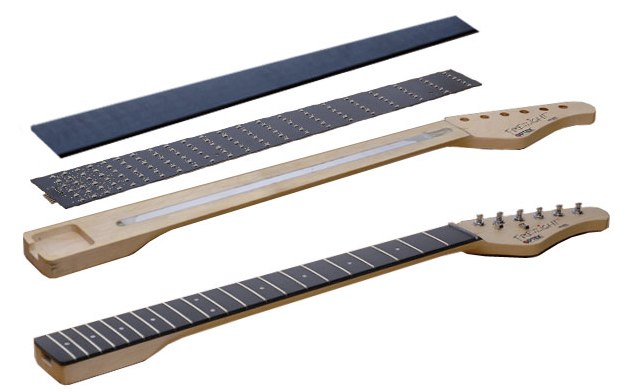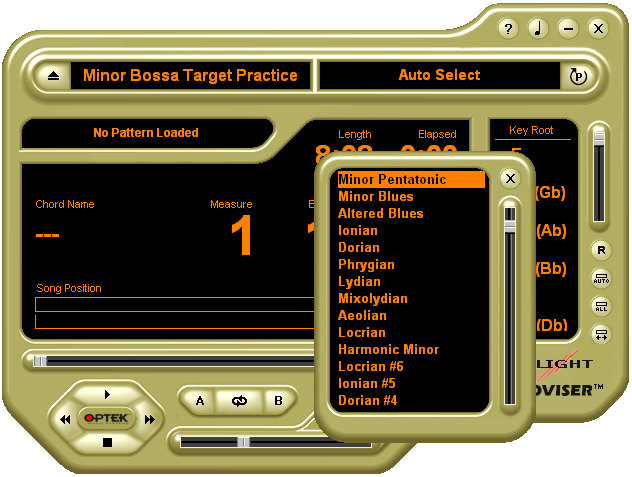
You may be first wondering what a “FretLight” guitar actually is. Most likely you’ve seen or heard of the concept, as it’s been around now for over 20 years. This is the guitar with the LEDs embedded into the fretboard that light up and show you how to play…well, just about anything you want to learn. Songs, chords, scales, just follow the glowing dots on the fretboard.
First off, I want to mention that this guitar, originally was something I had given very little thought to. I’d see mention of it from time to time on various guitar and technology sites, but pretty much wrote it off as a gimmick and not a serious tool. And this is exactly what I told Carol Arnold,the marketing person that contacted me about doing a story on their guitars. But she persisted, saying that the technology really needed to be experienced first hand in order to realize its benefits. So I decided to try and be open-minded and agreed to have them send me one for review.
There are several models of the fretlight guitar with prices starting at $399.99 for the 411 model. The guitar for review that I received was the FG-421 with a tobacco sunburst and retails for $499.99. It’s basically a Strat copy, with a maple modern C shaped neck, medium jumbo frets, alder body. Of course the fretboard is neither rosewood nor maple, but a patent pending polymer that appears black when the LEDs are not lit, but remains translucent enough for them to shine through clearly. Over all I was impressed with the fit and finish and I liked that they used a string-through bridge design as I feel they can help with the tone and sustain.

Before receiving the guitar, I had wondered if the plastic fretboard would be a turn-off. But I had taken it out of the box and played it for half an hour before I remembered to even take notice of it. It actually has a nice, smooth, slightly satin feel to it which I didn’t mind at all. It’s also possible this polymer fretboard will make the neck much more stable, as it’s immune to temperature and humidity changes that make normal necks require occasional adjustments.

The action was nearly perfect – very low with no buzzing unless you really dug into the strings. The fret ends were also all nicely smoothed. I’m told that each Fretlight is set up by one of their techs, and each guitar then tested by several resident guitar players at Optek, the company that makes the Fretlight. The guitar also had a hangtag declaring that D’Addario strings were installed. This is probably one of the better setups I’ve ever experienced “right out of the box”. This is important for new players, as a badly set up guitar makes it more difficult to play, adding to the frustration of beginners who tend to think it’s difficult because they are doing something wrong.
The guitars tone was probably its weakest point. Similar to many other guitars in this price range, the pickups, while totally adequate, are a bit bland sounding. But when your just starting out this isn’t a major priority, and pickups are easy to change. For an additional $99.99 you can get upgraded Shelby Designs pickups pre-installed. Optek offers Lindy Fralin pickups on their FG-431(Telecaster clone) for an additional $199.99.
To use the guitar requires installing the included software, and then plugging in the included special midi cable to a USB port on your computer. I’d assumed there’d be a way to also play back the guitar’s sounds through the computer, but this isn’t the case. The special cable is only for lighting up the frets, you’ll need to plug in the guitar to an amp, or whatever you normally use, through the standard 1/4″ jack.
There’s a decent amount of software and lessons to get you started. The Fretlight Studio, that’s part of the main install CD, comes with several components including a chord and scale library, which is exactly what it sounds like. Lighting up hundreds of different chords and scales for you to learn. There is also the Improviser, that includes 149 backing tracks and then allows you to choose from various scales, modes or chord tones that are appropriate for it, to light up the fretboard with. This is probably my favorite way to use the the Fretlight. Having these different patterns light up the fretboard, and changing to match the backing track, allowed me to start seeing new types of patterns and riffs that just weren’t as apparent when just looking at just tablature or chord diagrams.

The third component of the Fretlight studio software is the player. This is where any song lessons are loaded into. This includes the beginner lessons that come on a DVD which is also included with the guitar, as well as all the additional song lessons you can buy from the online store. The player allows you to slow down and loop any portion of the lesson and switch between different parts such as rhythm or lead.
Newly added to the bundled package is a DVD of Beatles song lessons. This DVD was done by the Hal Leonard Corporation and feels much more polished, and is better instructed then the Beginners lessons which are serviceable but lack the on-screen tab and multiple camera angles the Beatles lessons offer.
Finally, while not included with the guitar, the Fretlight is compatible with the popular tablature player/editor Guitar Pro 6. Though it requires a special Fretlight edition which is a $39.99 upgrade from GP6, $59.99 from GP5, or $99.99 to buy outright. The special Fretlight edition has all of GP6’s usual features, and also will light up the Fretlights LEDs with whatever TAB you load into it. This means that, along with all the learning material that comes with the Fretlight, you now can also use it with the thousands of guitar tabs available on the net and even write your own songs or excercises. This greatly expands the Fretlights use, and seems a worthwhile purchase once you’ve gotten through the included lessons.
Following the lights on the fretboard is the primary feature of the Fretlight, but also the element I initially was least enthused about. I’ve played guitar for many years and have always learned from sheet music, tablature and chord diagrams. And when I first started using the Fretlight, I have to say it felt awkward and un-natural. But the Improviser program kept me interested in continuing to use it, and as I did, I found looking at the fretboard for direction becoming easier and more natural.
I have to say, I really didn’t think I was going to be won over to the Fretlight quite as much as I have. And although it may seem expensive if your a beginner buying their first guitar, don’t underestimate the value of all the very useful software and videos. Some people may have a harder time getting used to this method of learning, especially those who have been playing a while. But newcomers to the guitar won’t have any old habits to overcome and should be able to get through the initial learning curve much faster. Either way, the Fretlight guitar seems like a truly legitimate tool for the beginner just starting out, or intermediates trying to improve practice routines, fretboard knowledge and breaking out of that all too common mid-level plateau.

